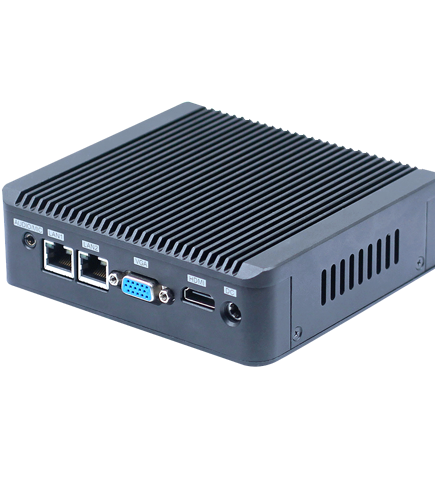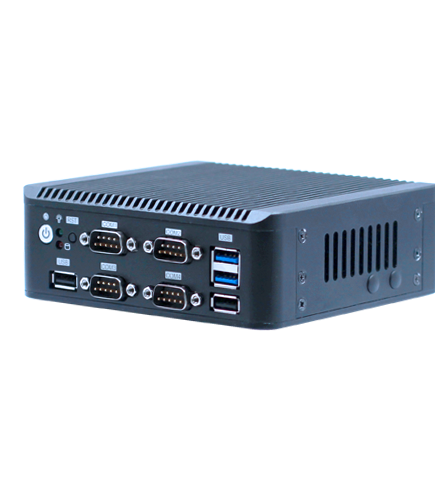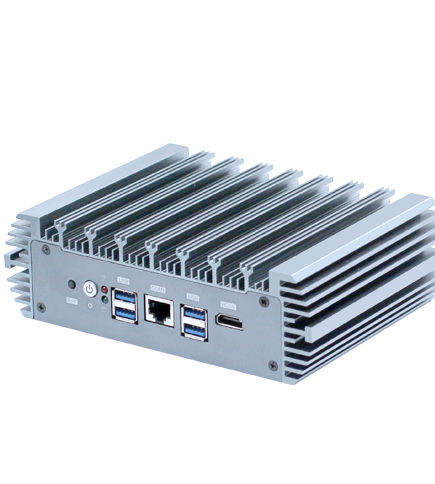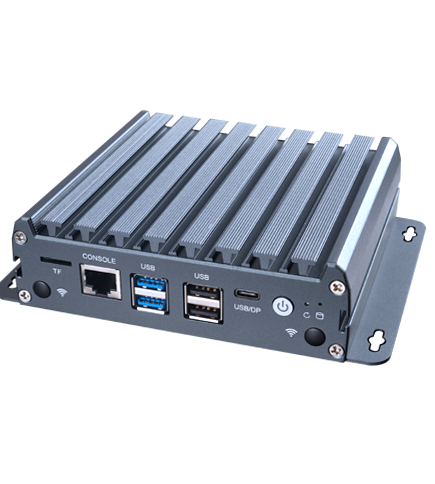
У свету рачунарства који се брзо развија, ПИЕСИА се истиче као пионир у технологији мини рачунара без вентилатора. Ови компактни, али моћни уређаји револуционишу индустријски сектор захваљујући свом тихом раду, енергетској ефикасности и поузданим перформансама. Као национално високотехнолошко предузеће специјализовано за индустријске матичне плоче, комплетне машине, рачунаре и сродне производе, ПИЕСИА је била на челу иновација у мини рачунарима без вентилатора.
ПИЕСИА мини рачунари без вентилатора дизајнирани су да задовоље јединствене потребе индустријских апликација. Ови рачунари су направљени да издрже тешка окружења, са кућиштем отпорним на прашину и ударце које гарантује њихову издржљивост у стварним ситуацијама. Недостатак вентилатора значи смањено одржавање и мање шансе за квар због накупљања прашине или хабања. Штавише, ови мини рачунари троше знатно мање енергије од традиционалних рачунара, што их чини еколошки прихватљивим избором за предузећа која желе да смање свој карбонски отисак.

У стално променљивом индустријском рачунарском окружењу, ПИЕСИА је изузетан бренд за своје компактне рачунаре који немају вентилаторе. Ови производи су елегантни и моћни да задовоље потребе индустријске аутоматизације, контролних система и других који су критични за мисију.
ПИЕСИА мини рачунари без вентилатора представљају пример поузданости и ефикасности. Бешуман је због недостатка вентилатора па их одржава мирним током рада што их чини погодним за употребу на високо загађеним местима. Такође гарантује издржљивост и смањене трошкове одржавања.
Преданост компаније иновацијама може се видети у броју функција и функција доступних са њиховим мини рачунарима без вентилатора. Имају процесоре високих перформанси, велике величине меморије и напредне графичке компоненте упаковане у своје мале оквире, због чега се могу користити у различитим индустријским областима. Аналитика података, машински вид или чак контролни системи у реалном времену су неке области у којима ПИЕСИА мини рачунари без вентилатора спашавају дан обезбеђујући потребан ниво перформанси за несметан рад.

Национална организација главног технолога, ПИЕСИА се специјализовала за производњу индустријских контролних матичних плоча, комплетних машина, рачунара и других повезаних производа у сврхе истраживања и развоја. Ова компанија је променила игру на тржишту мини рачунара без вентилатора са својим невероватним перформансама и издржљивошћу за критичне апликације. Са напредном технологијом и пажљивим дизајном, ПИЕСИА мини рачунари без вентилатора гарантују бескрајно функционисање чак и под екстремно тешким условима, стога их углавном преферирају играчи у индустрији који се баве индустријским контролним системима.
Невероватна ствар у вези са ПИЕСИА-иним мини рачунаром без вентилатора је да је мале величине, бешуман и добро изграђен. Ови компактно дизајнирани уређаји имају одличне елементе за расипање топлоте који су нови на тржишту, али не захтевају вентилаторе. Поред тога што га ова карактеристика чини издржљивијим, нема прашине или честица које се могу скупити на или унутар уређаја када ради у прашњавом фабричком окружењу. Поуздано ефикасно решење за индустријску контролу се мора очекивати од ПИЕСИА по индустријама због његове посебне природе.

ПИЕСИА, водеће национално високотехнолошко предузеће које је специјализовано за истраживање, развој, производњу, продају и постпродајне услуге индустријских матичних плоча, интегрисаних машина, рачунара и сродних производа, са поносом представља наша мини ПЦ решења без вентилатора. Мини рачунари без вентилатора из ПИЕСИА су пројектовани за поузданост и перформансе да задовоље тешке захтеве индустријских подешавања.
Да бисмо обезбедили одличне резултате на веома иновативне начине, направили смо веома мале, али чврсте уређаје. ПИЕСИА-ина посвећеност квалитету је омогућила да ови мали али ефикасни рачунари служе многим другим производним процесима. Наши производи се могу користити у било којој индустрији јер су компактни и имају флексибилну примену. Ове карактеристике су препознали и ценили многи купци који су их сматрали корисним за свој рад.
У ПИЕСИА-и постоји разумевање колико је важно да неки уређаји буду без вентилатора у тешким индустријским окружењима. Наши мини рачунари без вентилатора су смештени у робусно кућиште које је отпорно на прашину, као и на вибрације због којих раде несметано чак и у најгорим условима. Долазе у компактном дизајну са реномираним именом ПИЕСИА и модерним технологијама које су стога најпогодније за функције као што су прикупљање података, контрола процеса, као и аутоматизација, што их чини непроцењивим алатом за индустријску аутоматизацију и системе управљања до сада.

ПИЕСИА, реномирани бренд индустријских рачунарских решења, бави се развојем, производњом и доживотном подршком мини рачунара без вентилатора. Као напредно национално високотехнолошко предузеће, позиционирали смо се на тржишту тако што смо обезбедили чврсте, али мале величине и тихе рачунаре за различите области са њиховим изузетно захтевним захтевима. Наши мини рачунари без вентилатора показују нашу посвећеност поузданости, енергетској ефикасности и водећој технологији која нуди повећану оперативну стабилност и ниже нивое буке за индустрију.
Ми у ПИЕСИА дизајнирамо наше мини рачунаре без вентилатора да издрже тешка окружења где су отпорност на прашину, издржљивост као и сталне перформансе важни. Ови танки дизајни садрже компоненте прве класе без употребе бучних вентилатора за њихово хлађење, што их чини погодним за апликације као што су производна постројења, аутоматизовани системи и уграђени контролни системи. На основу наше стручности у дизајнирању поузданих матичних плоча и робусног рачунарског хардвера, сваки ПИЕСИА мини рачунар без вентилатора је креиран са дугим животним веком и непрекидним сервисом на уму.

Shenzhen ZunSia Intelligent Technology Co., Ltd. Osnovana 2009. godine, Kompanija je nacionalno visokotehnološko preduzeće usredotočeno na istraživanje, razvoj, proizvodnju, prodaju i posleprodajni servis industrijskih kontrolnih majčini, kompletnih mašina, računara i povezanih proizvoda, sa 14+ godina iskustva u ovom sektoru.
Pružamo kupcima usluge prilagođene po jednom modelu , Naše proizvode se široko primenjuju u industrijskoj automatizaciji, komunikacionom opremi, energetske sisteme, mrežna sigurnost, inteligentnom saobraćaju, video nadzoru, zdravstvu, odbrani, aeronautici, samoodržnim terminalima, skladišnim uređajima, digitalnim tabelama, ugrađenim računarima, potrošačkim elektronikom i više.
Više od 10 godina iskustva u delu, eksport u 23 zemlje.
Usluga jednostruke usluge, da vam pruži proizvode višeg kvaliteta.
Da vam pružimo odgovarajuće proizvodne rešenja.
Vodeća jezgra tehnologije u delu, pažnja na detalje, stroga kontrola kvaliteta.
Мини рачунар без вентилатора је компактан рачунарски систем који ради без уграђеног вентилатора за хлађење. Користи пасивне технике хлађења као што су хладњаци и топлотне цеви за одвођење топлоте, што резултира тишим радом и побољшаном поузданошћу.
Коришћење мини рачунара без вентилатора нуди неколико предности. Прво, елиминише буку коју стварају традиционални системи за хлађење засновани на вентилаторима. Друго, смањује ризик од накупљања прашине или крхотина, што доводи до побољшања дуговечности система. На крају, пружа компактно и енергетски ефикасно решење погодно за различите примене са ограниченим простором.
Мини рачунари без вентилатора се широко користе у апликацијама где су важни смањење буке, отпорност на прашину и компактност. Обично се користе у индустријској аутоматизацији, дигиталним сигнализацијама, кућној забави и имплементацији ИоТ-а (Интернет оф Тхингс).
Мини рачунари без вентилатора обично нуде више опција за монтажу, као што су ВЕСА монтажа или монтажа на ДИН шину, у зависности од намераване примене. Препоручљиво је да прегледате спецификације производа или да се консултујете са нашим продајним тимом како бисте одредили доступне опције монтаже за одређени модел.
